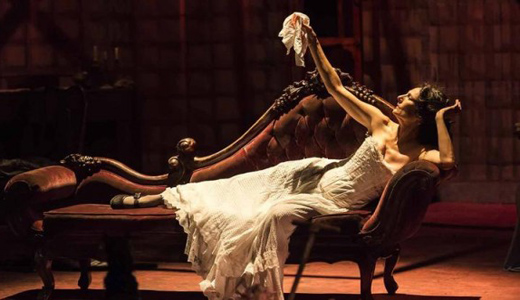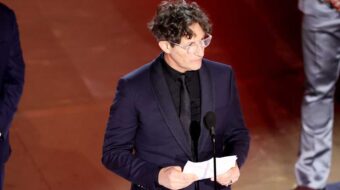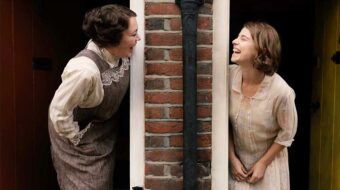
This production of the Swedish playwright August Strindberg’s 1900 The Dance of Death, now playing at A Noise Within (ANW) in Pasadena, is expertly acted and directed by Julia Rodriguez-Elliott and Geoff Elliott. The latter also co-stars as the former artillery captain Edgar, who is enmeshed in the most miserable marriage this side of Edward Albee’s George and Martha in Who’s Afraid of Virginia Woolf?, not to mention those suffering Scandinavian spouses in countless downbeat Ingmar Bergman movies often starring the Swede’s stock players, such as Liv Ullmann in the bleak Scenes From a Marriage.
In Dance, ANW resident artist Susan Angelo masterfully depicts has-been actress Alice, the other half of this unhappy marriage — or perhaps I should say the other “third” of what becomes a triangle, once the couple’s old “friend” and Alice’s cousin, Kurt (Eric Curtis Johnson), enters the fray.
This Dance is a new version adapted by the noted Irish playwright Conor McPherson. What ANW presented on stage seems to be The Dance of Death I, not including the second part of the play, which Strindberg also wrote in 1900. McPherson’s adaptation stresses Strindberg’s gallows humor. Many in the audience, myself included, laughed and smiled at the black comedy elements — although many of the not-quite guffaws might stick in your throat.
The Dance of Death not only clearly influenced Albee but also the Theater of the Absurd. There’s something terrifying about this grim, glum, gloomy view of marriage and “love,” with the couples tearing each other apart, instead of supporting, nurturing and (dare I say?) loving one another. Do some people marry for the purpose of humiliating one another à la Virginia Woolf? Yikes! This distressing thought is truly frightening. Is this why Edgar and Alice married? Do they hate themselves and each other so much that the purpose of their marriage is to psychologically and physically ransack one another? Is it all one big game of marital discord? If that’s the sorry case, so much for wedded bliss.
This depressing notion is a strain of thought repeatedly expressed in arts reflecting the Scandinavian psyche: Dramatists Strindberg, Henrik Ibsen, painter Edvard Munch (who gave us The Scream), filmmakers Victor Sjöström, Carl Theodor Dreyer, and of course Bergman, whose 1957 masterpiece The Seventh Seal literally closes with a dance of death. Even the marriage of Birgitte Nyborg (Sidse Babett Knudsen), the fictionalized first female prime minister of Denmark in the stellar Danish TV series Borgen, falls apart: Not even her nation’s most powerful person can keep her marriage together. (A complete three-season DVD set of Borgen — arguably one of the best series in television history — has just been released.) So what gives with those Danes, Finns, Norwegians, Icelanders, and especially those Swedes? Is it those long winter nights? Or is this existential, angst-ridden side just another stage/celluloid stereotype? Inquiring minds want to know.
McPherson’s adaptation, which accentuates the dark humor presumably inherent in Strindberg’s original intent, lightens the load and makes this classic more palatable for contemporary theatergoers. Leavened by levity and laughter, the comedic aspect makes the tragic elements easier to take.
According to the playbill, in 1884 Strindberg “was tried and later acquitted for blasphemy for a collection of short stories he wrote called Getting Married.” The writer also wed and divorced an actress, Siri Von Essen. He eventually separated from his third wife, Harriet Bosse, also an actress, all of which might inform Strindberg’s jaundiced view of Dance‘s Alice.
Perhaps it’s just coincidental or maybe something’s in the Southern California air, but this is the fifth play I’ve seen in about a month (Much Ado about Nothing, Albee’s The Goat, Samuel Beckett’s Happy Days, Rogue Machine’s Cock), that deals with troubled marriages or relationships where the alienated participants rip each other to shreds. With laughter amidst the agony of marital mayhem and relationship wretchedness on stage, let the games begin!
The Dance of Death runs through Nov. 23 at A Noise Within, 3352 East Foothill Blvd., Pasadena, CA 91107. For exact times, dates and more info: (636) 356-3100, ext. 1; www.anoisewithin.org.
Photo: Scene from “The Dance of Death.”












Comments